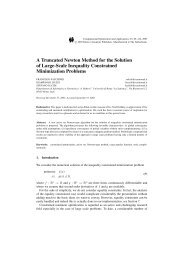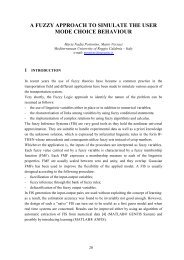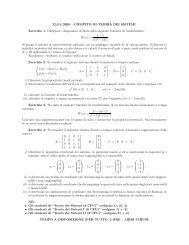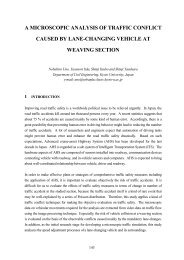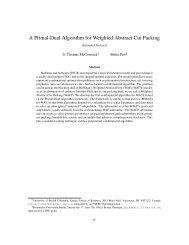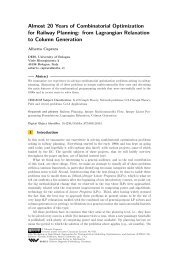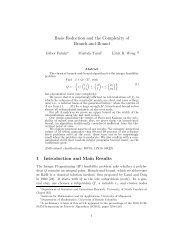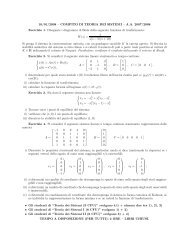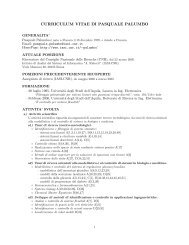GENERATING DENSE RAILWAY SCHEDULES 1. Introduction
GENERATING DENSE RAILWAY SCHEDULES 1. Introduction
GENERATING DENSE RAILWAY SCHEDULES 1. Introduction
You also want an ePaper? Increase the reach of your titles
YUMPU automatically turns print PDFs into web optimized ePapers that Google loves.
Generating dense railway schedules 291<br />
The paper is structured as follows. Section 2 describes the two modelling levels. Section<br />
3 addresses the problem of avoiding deadlocks in the modelling. Section 4 describes the<br />
optimisation problem and the applied heuristic. Section 5 shows the obtained results.<br />
Finally, Section 6 gives our conclusions.<br />
2. Two Level Model<br />
The typical layout of a main station region consists of stretches of several parallel tracks<br />
leading to different major directions. These stretches are connected by switch regions to<br />
make all tracks accessible. The important fact is that the switch regions are short relative<br />
to the stretches and are, therefore, passed quickly by trains. Choosing routing and train<br />
precedence is separated by creating an aggregated global topology in which each switch<br />
region is reduced to a node providing connections among all incoming tracks. A train<br />
run now consists of a series of stretches with interconnecting nodes. Thus, the route is<br />
fixed except for deciding which of a number of parallel tracks to use, see Figure 1 for an<br />
example. Now, train precedence can be determined for each stretch individually subject<br />
to the available capacity that is given by the number of parallel tracks present. Choosing<br />
train precedence in this topology will generate a tentative timetable which guarantees that<br />
capacity restrictions on the stretches are met.<br />
Portal Node<br />
Portal Node<br />
Switch Node<br />
Main Station<br />
Switch Node<br />
Portal Node<br />
Figure <strong>1.</strong> Example of an aggregated station topology.<br />
Petri Nets provide an ideal means for modelling and analysing timetables [5]. These<br />
tools not only make it possible to easily calculate the cycle time of a timetable but also to<br />
find the specific sequence of events within the timetable that prevents a further tightening<br />
of the schedule without changing some train precedence. As a modelling tool, Petri Nets<br />
allow incorporating train precedence and interconnections as well as capacity restrictions on<br />
stretches with parallel tracks and, therefore, fit the modelling requirements on the aggregated<br />
level which gives reason to use them here.<br />
Independent Set Modelling of the Lower Level<br />
Now assume that a timetable has been found in this simplified aggregated topology. Is it<br />
feasible? Not necessarily, since it was assumed that the switch regions had infinite capacity.<br />
Therefore, the tentative timetable has to be checked in a fully detailed track topology of<br />
each switch region. The tentative timetable is feasible if a routing for all trains can be found



